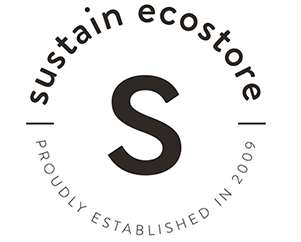Canada's Zero Plastic Waste Strategy

Above: Charlie and Finn fishing a discarded single-use water bottle from a local waterway during last year's Sustain Earth Day cleanup (see additional images).
Much of the work that we do at Sustain revolves around helping people reduce or even eliminate single-use plastic. Its an important issue, and it's also a pervasive issue - plastic has permeated the natural world to such an extent that it is now in the water, and in the food chain. It's such a big issue that fixing it seems largely impossible! It might surprise you though to learn that the government is talking about it, and while no large scale solutions have been put into practice, Canada launched an Ocean Plastics Charter during the 2018 G7 which has now been adopted by Canada, France, Germany, Italy, the United Kingdom, and the European Union, and a Strategy for Zero Plastic Waste has been put forward and accepted by the Canadian Council of Ministers for the Environment.
Since the 1950s 8.3 billion tons of plastic has been generated around the world and only 23% of those plastics have been recovered or recycled. Currently, the national stats are that 89% of plastic is landfilled or incinerated. So how do we start to change that? Many believe it starts with changing how we value recovered materials - plastics are cheap and easy to make and yet get this: "Today, an estimated 95% of the material value of plastic packaging, or between $100 and $150 billion dollars annually, is lost to the global economy after only a single use....Redefining plastic waste as a valuable commodity presents an economic opportunity to conserve resources and build on our [Canada's] competitiveness." The circular economic model is really where it's at!! Using the model we can easily negate the popular belief that saving the environment is too expensive or will ruin the current economy.
Because it's interesting to know (vital actually in order to understand where best to target our efforts), here is a brief synopsis of the Canadian Strategy for Zero Plastic Waste. Find the entire document here if it interests you to read more!
The Strategy recognises the interdependence of three areas of activity as elements of an integrated system: prevention, collection and clean-up, and value recovery.
The CCME strategy focuses on:
1. Preventing plastic waste, for example by designing plastic products for longevity and reparability, or reducing demand for disposable plastic items;
2. Collecting all plastics, including through clean-up, so they are channelled back into the economy; and
3. Recovering value from all plastics using a range of strategies and processes according to a hierarchy of priority.

Framework for Action:
"Ten priority result areas for actions have been identified based on Canadians’ and stakeholders’ views about plastic waste, and findings from evidence-based analysis. These ten results areas will drive the development of future actions and orient collective efforts to achieve zero plastic waste."

1. All plastic products are designed for greater durability, reuse and recycling - currently plastics are very diverse and often different types are mixed, which greatly complicates capturing and processing them for recycling and reuse. "Integrating reuse and recycling considerations into the design of plastic products is necessary to reduce the costs of bringing these materials back into the economy."

2. Eliminate single-use plastics (unless required for health and safety). This step requires adoption and acceptance of changes in consumer behaviours on a wide-scale (this is where we come in - lets make reusables mainstream!!), as well as participation by businesses in the types of materials they make available for their customers (think takeout cups and containers!).
3. Improving collection programs - removing barriers to collection, simplifying plastics for easier recycling, harmonizing collection programs, increasing producer responsibility (make companies responsible for their waste and encourage take-back programs).
4. Create a stronger domestic market for recycled plastics - this is a tough one as depending on the price of oil sometimes recycled plastics are more expensive than virgin. The most promising solution is to make recycled materials more desirable though policies and fee structures; a deposit-refund program also has been proven to work well, both to ensure consumer participation and to incentivise companies to create products they can easily recapture and reuse.
5. In order to recover value from all used plastics, Canada’s recycling infrastructure will need to be significantly expanded, as well as increase capacity to deal with contaminated or dirty plastic to eliminate rejection rates during recycling and provide an outlet for collected plastic litter. Here's the cool part: "recent studies suggest that increasing the overall plastics recycling rate from 11% to 75% would create an estimated 15,000 jobs, prevent up to 4 megatonnes of carbon dioxide emissions, and contribute more than $700 million to Canada’s GDP."
6. Empower Canadian households, businesses and institutions to prevent and manage plastic waste responsibly - we're all in this together!
7. Reduce ocean plastic contamination through fishing activities - its well-known that this a major problem.
8. Improve Research - "Decision makers require robust evidence to support meaningful actions and to measure the effectiveness of policy and regulatory measures. Research can take place on a number of fronts, to improve understanding of where macro- and micro-plastic pollution comes from, how it enters the environment and, the impacts it has on people and the environment."
9. Cleanup & Prevention of environmental plastic contamination - In 2010 about 8,000 tonnes of plastic waste entered oceans from land in Canada. Without any action this could almost double by 2025. Right now the most effective way to remove it is through human effort, picking it up one piece at a time (more widescale methods are being considered, but prevention is by far the most important step).
10. Become leaders as Canadians and continue to take part in the global effort to reduce.
In Conclusion:
It can be frustrating, as people who have cared about this issue for years can attest, to read about setting reduction targets far into the future like 2030, 40 or 50. Understanding how limited our infrastructure truly is to deal with the issue helps shed a little light on why projections are so far into the future. So what can we do now? Continue to support a ban on single-use plastic, continue to reduce/eliminate consumption habits (see below), support companies and businesses working to offer alternatives, and host clean-ups in your area!! Check out shorlinecleanup.ca or check out this past journal entry for our quick tips.

MORE RESOURCES:
If you haven't yet already, check out our guides to zero/low waste grocery shopping and plastic-free takeout. Even if you adopt a single change at a time before long you will notice the difference it makes!
All photos by Danielle Taylor Photography for Sustain.
Source: Strategy for Zero Plastic Waste



